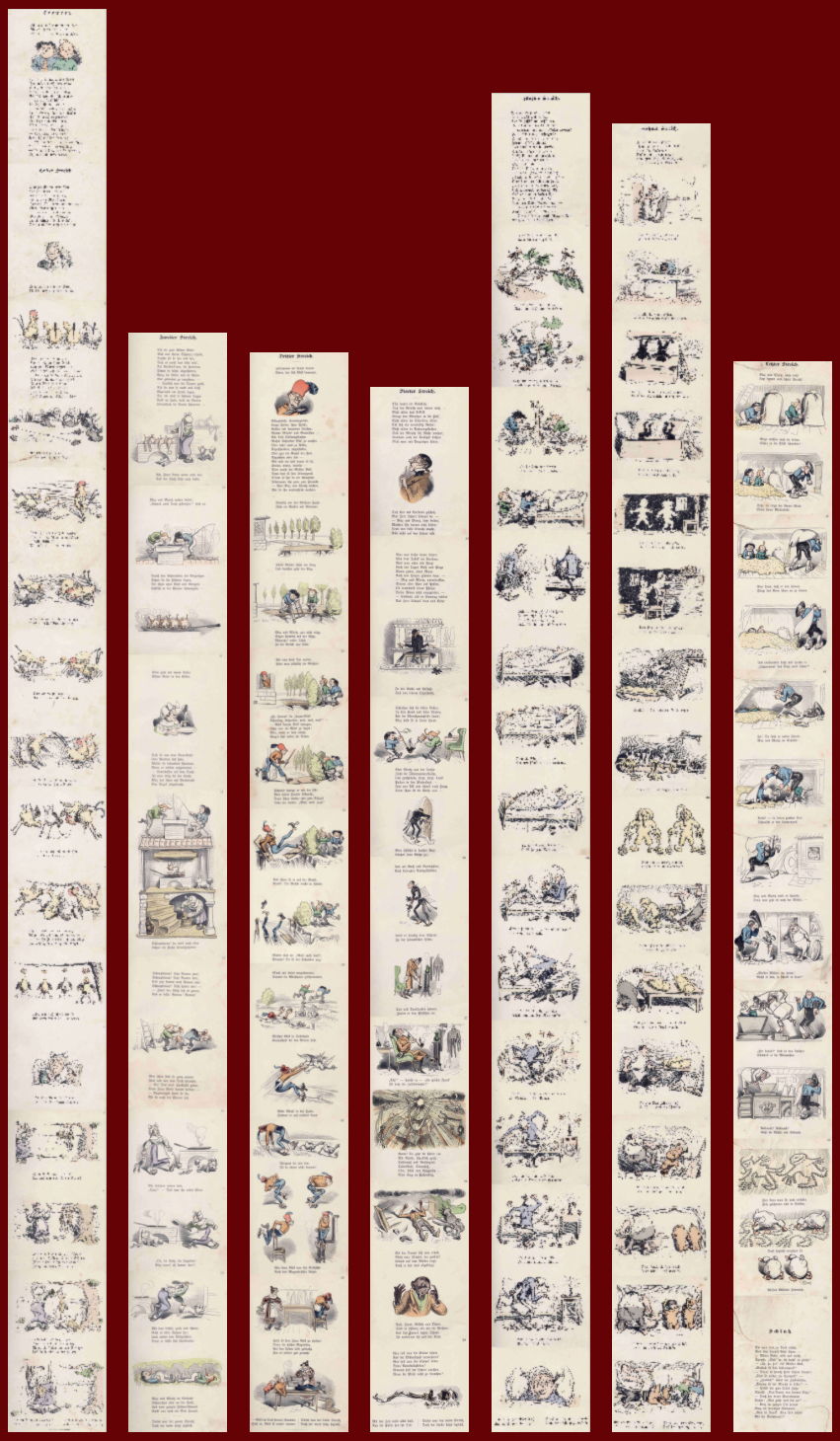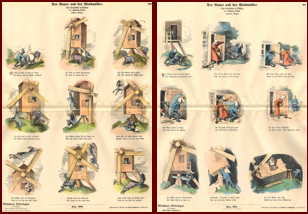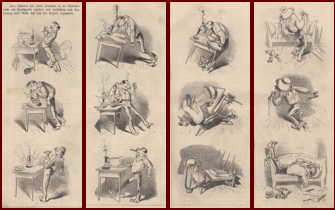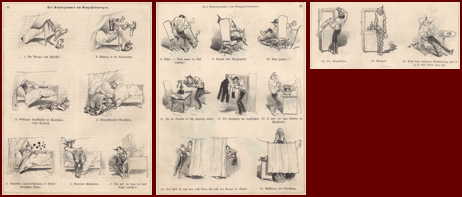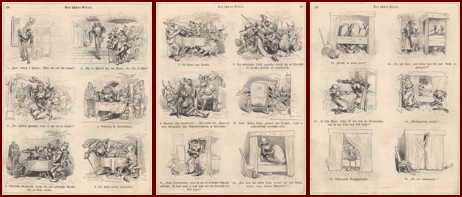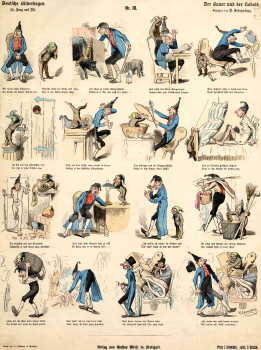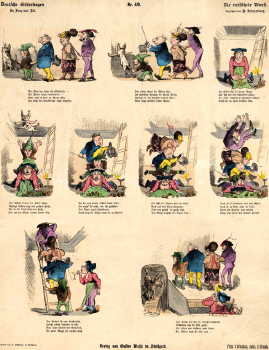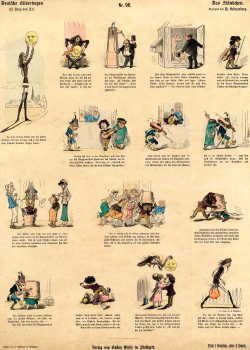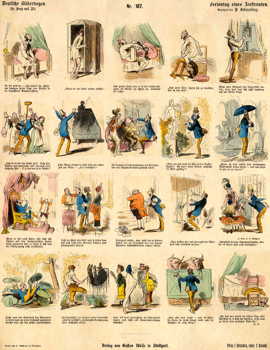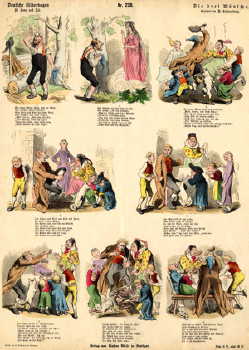
Home A-Z A-Z text British German Unidentified Reprint Birth Sunday Chronological
Early German Comics
1700 - 1800
|
Franz Joseph Goez 'Lenardo und Blandine' 1783 |
|
Ironically this, the first actual graphic novel(ette), probably had little influence. It was too ahead of its time as far as the comic-structure is concerned. In content it was delightfully very much of its time, full of outrageous melodrama.
Here's the complete sequence, with my translation underneath: |
page 1-34
page 35-65
page 66-93
page 94-125
page 126-160
All on one page
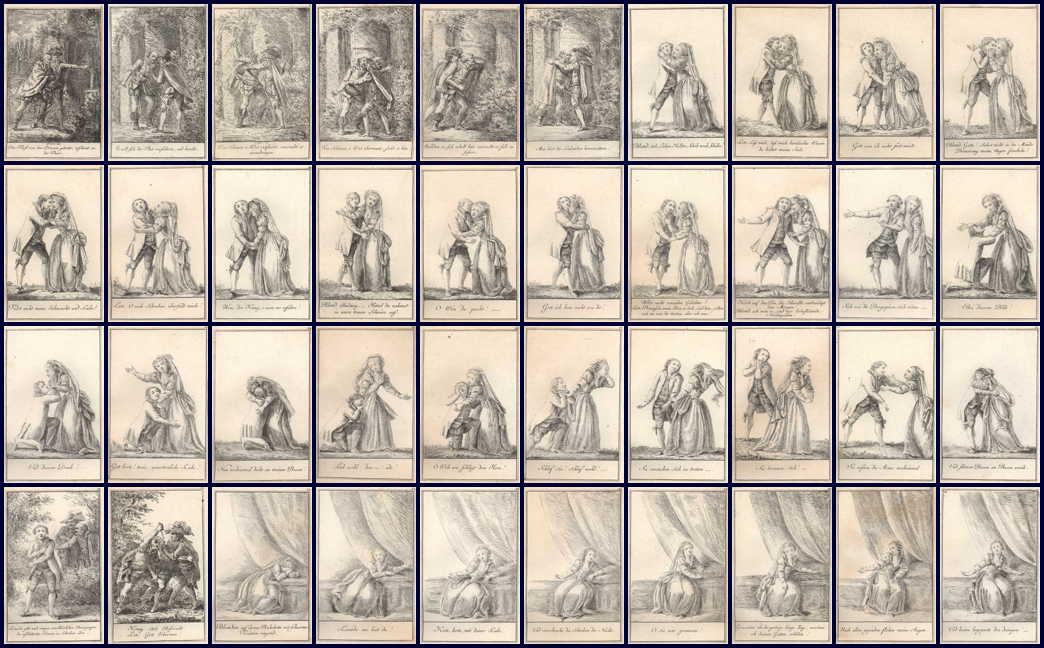 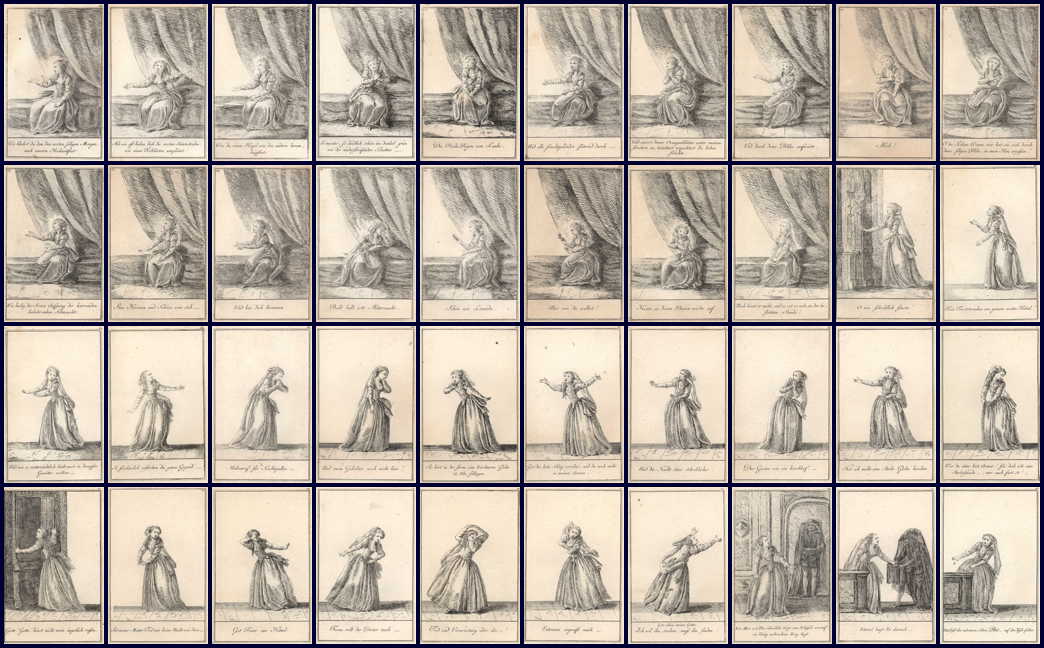 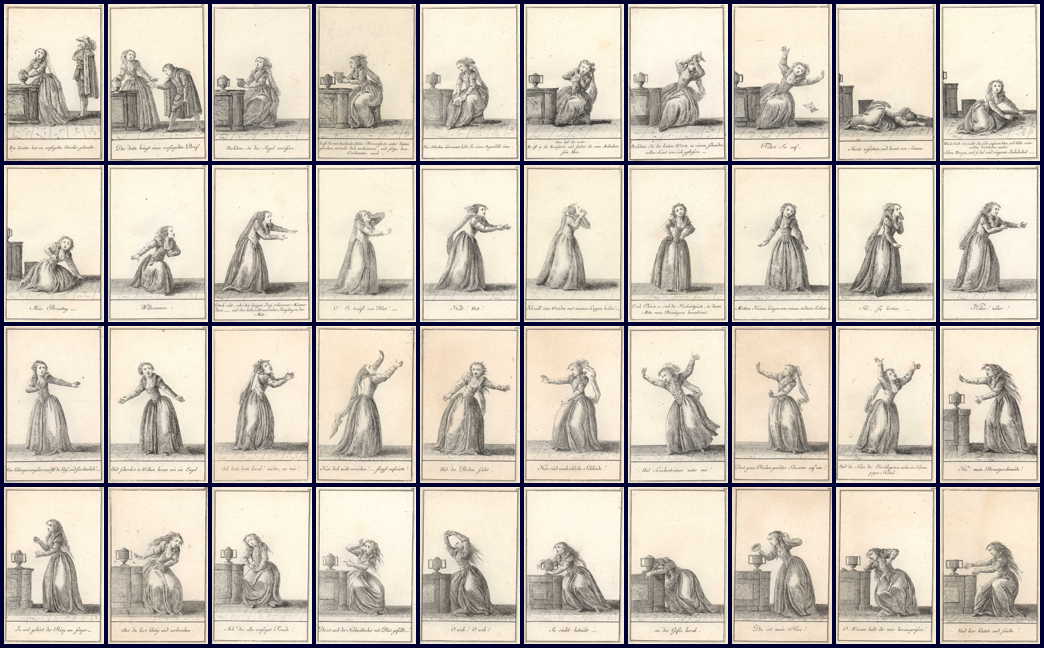 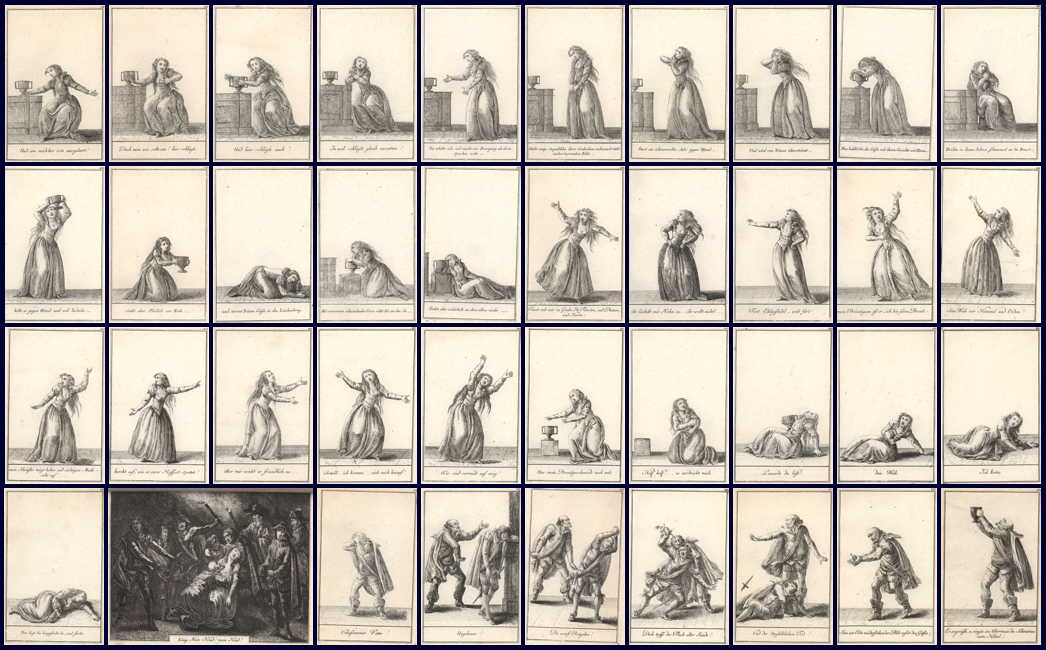 |
1800 - 1840 (pre-Töpffer)
|
Geschichte der Madam Rips und ihres Hundes Bello 1835/40 This sheet demonstrates the international influence of British picture stories - a close copy of Old Hubbard, translated into German: (the English version was here) . Bello comes from 'bellen', to bark. Typical doggie name. 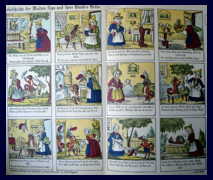
More common were these charming fairy tale adaptations: Cinderella 1835/40 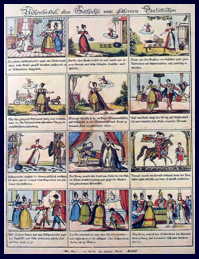 Hansel and Gretel (here called Martin and Ilse) 1835/40 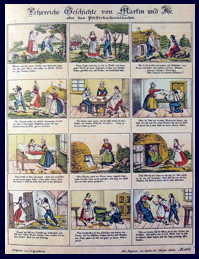 Erzählung vom kleinen Däumling / Story about Little Tom Thumb (1835/40)  Schneeweisschen und Rosenrot (1835/40) (Little Snowwhite and Rosered) (not the Snowwhite, who is called 'Schneewittchen' in German) 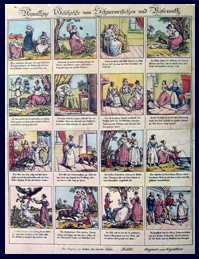 There were also popular stories of romantic robbers: Rinaldo Rinaldini (1835/40) ... 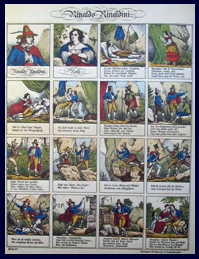 ...or a satire for grown-ups about emancipated women (and why to avoid them): Der Kleine Mann und die grosse Frau (The little Man and the large Woman) (1835/40) 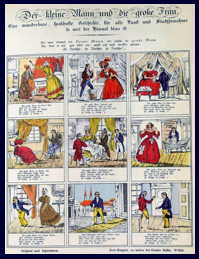 |
| Heinrich Hoffmann 'Struwwelpeter' (drawn 1844, published 1847 - English edition 1848) |
| This famous picture book is stylistically related to earlier chapbooks and Bilderbogen / picture broad sheets. The hunter/rabbit story is similar to a panel from an earlier Bilderbogen showing (non-sequential) instances of a 'topsy turvy' world. |
 |
1840 - 1860 (pre-Busch)
Anonymous - Two comics from the magazine 'Die Illustrierte Welt' Stuttgart (1858) (sechster Jahrgang)
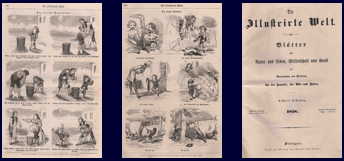 |
Wilhelm Busch
1860 - 1900
F. von B. 'Der schlaue Pepi - oder - Die geraubte Gans' (Fliegende Blätter vol 82) |
|
Johann Bahr 'Der kurzsichtige Bassgeiger' (The short-sighted bass-player) (without words)  'Schnelles Wachstum' (Fast Growth) (without words) 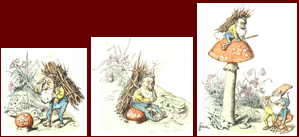 'The Mechanical Racehorse' (originally in 'Lustige Blätter' 1892, here also from 'Picture Magazine' 1893) 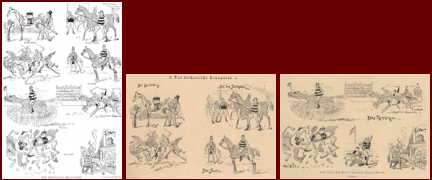 Die Rivalen auf dem Eise (Lustige Blätter 1892)  Die verrätherische Fata Morgana (Lustige Blätter 1892) (without words) (Speech by Professor Strubelmann on how to take care of your hair) (Lustige Blätter 1892)  Der kluge Plüsecke (Lustige Blätter 1892)  'Der Sonntagsfrevler - oder - Die verbotene Angelei' (Lustige Blätter 1892)  'Der gefoppte Schwarzseher' (Lustige Blätter 1892) (without words)  'Better than an Alarum 'The Clown Takes a Ride' 'Woes of a Chaperone' 1891 'A Nervous Lady Takes a Walk' 1892 'A Proposal under difficulties' 1892 'A Saving Man' 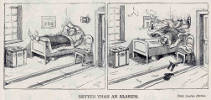

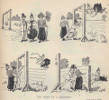
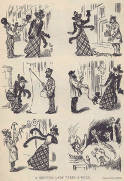
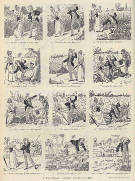
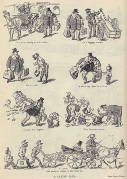
|
Gerlach 'A Tale of a Lamp and a Bath' (from'Universum', reprinted in Picture Magazine 1893) |
F. Graetz 'Die Wirkung der afrikanischen Sonne auf das Kilimandscharo-Gebiet' (1892) (Lustige Blätter)  |
|
A. Jensen 'Der Abgeordnete und der Wähler' (Lustige Blätter 1892) (the often repeated visual joke of relating the size of people to their power or importance)  'Die 'Vermehlung' des Schornsteinfegers' (Lustige Blätter 1892) 'Die Ratte' (Lustige Blätter 1892) 'Ein armer Lahmer' (Lustige Blätter 1892) 


|
C. Koch (Deutsche Bilderbogen 162 - Gustav Weise Stuttgart) 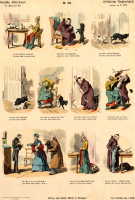
|
Ch. Lagemann 'Der zerstreute Professor oder Eine Überraschung' (Lustige Blätter 1892) 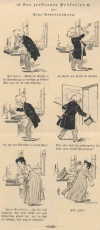 |
M. Mandl 'Praktische Verwertung der neuesten Mode' ('Practical application of the latest fashion') (1885) (Fliegende Bl&amul;tter vol 82) |
|
Lothar Meggendorfer Aus den Kinderjahren eines Kautschukmenschen (from the infant years of the plastic man)  Rache ist süss (Revenge is sweet)  Die schlauen Zwerge (The Clever Dwarfes)  Misslungene Arretierung (Unsuccessful Arrest)  Liebesgram und Heilung (Love sickness and Recuperation)  Das bockbeinige Schwein und der Philosoph (The recalcitrant pig and the philosopher)  Die Macht der Musik' (FB 1888) 
|
|
Adolf Oberländer Illustrierte Anzeige - Ein Grotesktänzer, durch Kabalne dem Ballett entrissen, empfielt sich als Bodenwichser  Ein jedes Tierchen hat sein Pläsierchen - 1885  Die kurzsichtige Tante (The shortsighted aunt) 1903  Münchener Tartarus (1865) Die unterbrochene Trauung (1865) Täuschung - (text with three illustrations) (1865) Der Wunderdoktor (1865) Zufalls Tücke - oder - Unfreiwillige Illustration - 1885 
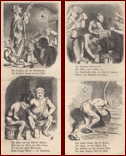


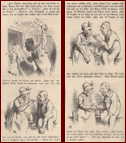
|
|
Karl Pommerhanz Ein Frechdachs Der getäuschte Arzt Die Benutzte Gelegenheit Die kleinen Verwandlungskünstler Der Herr Professor und das Feuerwerk 


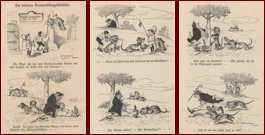
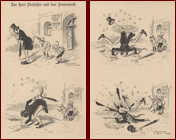 Das boshafte Geschwisterpaar Die Pferdelspieler Der kleine Turner und seine Lebensrettung 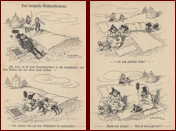
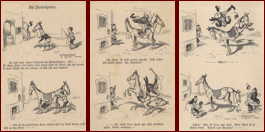
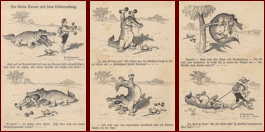
Bestrafte Unhöflichkeit (1892) 
|
Carl Reinhardt (Die Landpartie) (Deutsche Bilderbogen für Jung und Alt Nr.96) |
|
Emil Reinicke Das jähzornige Nashorn' (The angry Rhino) (1886)  Die verschwundene Wurst - Eine merkwürdige Begebenheit (FB 1885) Irren ist Menschlich (to err is human) (FB 1884) 
 Iberus - Eine antimusikalische Ballade (FB 1884)  Dr. Mokel in Afrika (FB 1884) Sächsisches Landsknechtlied (FB 1885) Das Kegelspiel - Historisches Gedicht (FB 1885) 

 Der Kluge Elefant (The clever elephant) (1902) Der durstige Jumbo' (Thirsty Jumbo) (1902) 

|
F. Reznicek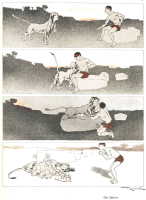
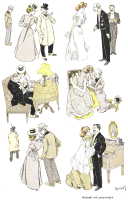
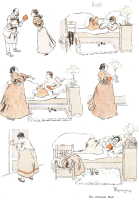 |
|
H. Scherenberg Der Bauer und der Kobold (The peasant and the kobold) Die entführte Wurst (The kidnapped sausage) Das Ständchen (The serenade) Ferientag eines Zerstreuten (Holiday of someone very distracted) Die Drei Wünsche (The three wishes) |
Schmelzer 'Hansl und Gretel - oder - Nach und nach' (1865) (Fliegende Blätter vol.46)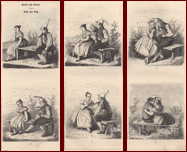 |
R. Schönborn (Drei Räuber) (Deutsche Bilderbogen Nr.105) 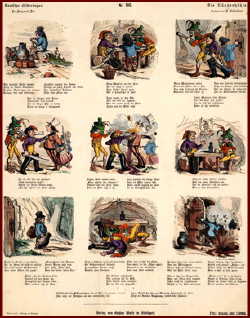 |
Schliessmann 'Der Sechsf┘ssler - ein Clownscherz' (The six-footer, a clownish joke) |
Arpad Schmidthammer (1905) This was very likely an inspiration for 'The Kinder-Kids' by Lionel Feininger. Schmidthammer's 'Mucki' had just been published when Feininger (living in Germany) was commisioned by the Chicago Tribune to come up with a comic strip. The style and content, especially the trip-round-the-world nonsense, shows similarities, although Feininger is far more inventive. - Schmidthammer himself was influenced by Busch, the plump parents are classic Busch (see Tobias Knop and wife), and the gag of hanging onto the stork is lifted from Max and Moritz.
  |
|
C. Storch Der Automobilfahrer wider Willen (The unwilling motorist)  Bestrafter Geiz (Punished Selfishness)  Blinder Eifer (Blind Zeal)  Glück im Unglück - Storch after Pomerhanz  Gnom und Maulwurf (Gnome and Mole)  Der Maler und der Stier (The Painter and the Bull)  Verunglückter Musikuntericht (The music lesson that went wrong)  Die Zwerge und der Fischer (The Dwarfs and the Fisherman) 
|
H. Storkmann (French reprint) (originally published in Fliegende Blätter) |
John Theele 'Die fünf Sinne' (The five senses) (Lustige Blätter 1892) |
M. Vaiselow 'Das gewohnte Stichwort' (Lustige Blätter 1892)  |
S. Vitou 'Der Photograph in der Wüste - Vorzug der Revolver Camera' (Lustige Blätter 1892)  |
If you have questions about early comics, please direct them to this mailing list: Platinum Age Comics
Copyright © 2014 by Andy Konky Kru
Home

